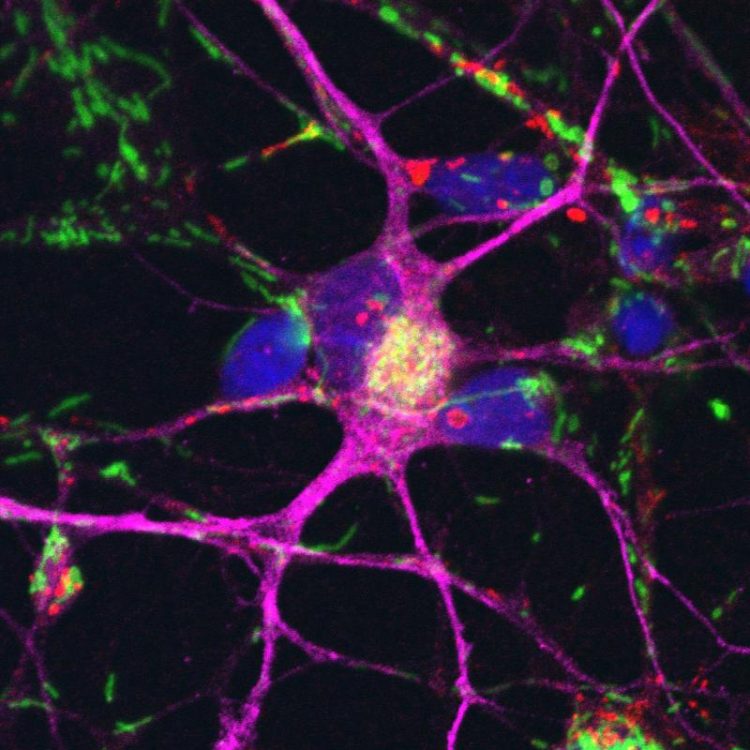Parkinson’s: Vitamin B3 has a positive effect on damaged nerve cells

Nerve cells (purple) grown from stem cells derived from Parkinson’s patients. The nuclei are colored blue and the mitochondria green. Copyright: Deleidi, 2018
Unsteady hands, stiff muscles and slow movements—all these are typical symptoms of Parkinson’s disease. Some 220,000 people in Germany are affected by the disease, which becomes more likely to occur as people get older. It is caused by the loss of nerve cells in the brain and remains incurable.
A team of researchers headed by Dr. Dr. Michela Deleidi at the Hertie Institute for Clinical Brain Research and the University of Tübingen is now reporting that nicotinamide riboside—a form of vitamin B3—may offer a possible treatment.
Initial results from the laboratory are promising: “This substance stimulates the faulty energy metabolism in the affected nerve cells and protects them from dying off,” Deleidi explains. The researchers have published their study in the latest edition of the journal Cell Reports.
Damaged power plants lead to cell death
It is still not clear precisely what leads to the development of Parkinson’s disease. Scientists do know that increasing levels of dopamine in nerve cells in the substantia nigra region of the brain die off. Recently it has been recognized that the mitochondria in these cells are damaged.
Mitochondria are responsible for producing energy, making them the mini-power plants of the cell. When they go wrong, the cell may die. “In our study we aimed to investigate whether damaged mitochondria were merely a side effect or whether they cause Parkinson's disease,” says Deleidi.
To find out, the researchers, working with international colleagues, took skin cell samples from patients with Parkinson’s disease. The stimulated the cells to turn them into stem cells, which then developed into nerve cells. The cells had a defect of what’s known as the GBA gene—the most frequent risk gene for Parkinson’s. Just like the ‘real’ nerve cells, their mitochondria—and consequently their energy production—were impaired.
Overhaul of cell power plants
The researchers then sought to stimulate the formation of new mitochondria. The coenzyme NAD plays and important role. The researchers ‘fed’ the cells with nicotinamide riboside, a form of vitamins B3 and a preliminary stage of the coenzyme. This led to a rise in the concentration of NAD in the cells. The result: “The nerve cells’ energy budget improved considerably. New mitochondria formed and energy production rose.”
In order to observe the effect of the vitamin in a living organism, the researchers took the further step of investigating flies with a GBA gene defect. As with Parkinson’s patients, the flies’ dopamine-rich nerve cells died off, and as they age, the flies have increasing difficulties in walking and climbing.
Deleidi and her colleagues divided the flies into two groups. One group received feed enriched with the vitamin, the other did not. “The substance had a positive effect here as well. In the flies which were treated, far fewer nerve cells died off.” Furthermore, they retained their mobility longer.
Possible treatment
“Our results suggest that the loss of mitochondria does indeed play a significant role in the genesis of Parkinson’s disease,” Deleidi summarizes. “Administering nicotinamide riboside may be a new starting-point for treatment.” Further studies are needed to determine whether the vitamin can be of real help with Parkinson’s. The researchers are planning to test the effects of nicotinamide riboside on patients. Other studies have shown that it is well tolerated by healthy test subjects and boosts their energy metabolism as well,” Deleidi says.
Publication:
Schöndorf DC et al. (2018): “The NAD+ precursor, nicotinamide riboside, rescues mitochondrial defects and neuronal loss in iPSC and fly models of Parkinson’s disease“, Cell Reports, 23(10)
DOI: 10.1016/j.celrep.2018.05.009
https://www.hih-tuebingen.de Hertie Institute for Clinical Brain Research
https://www.uni-tuebingen.de University of Tübingen
Media Contact
All latest news from the category: Life Sciences and Chemistry
Articles and reports from the Life Sciences and chemistry area deal with applied and basic research into modern biology, chemistry and human medicine.
Valuable information can be found on a range of life sciences fields including bacteriology, biochemistry, bionics, bioinformatics, biophysics, biotechnology, genetics, geobotany, human biology, marine biology, microbiology, molecular biology, cellular biology, zoology, bioinorganic chemistry, microchemistry and environmental chemistry.
Newest articles

NASA: Mystery of life’s handedness deepens
The mystery of why life uses molecules with specific orientations has deepened with a NASA-funded discovery that RNA — a key molecule thought to have potentially held the instructions for…

What are the effects of historic lithium mining on water quality?
Study reveals low levels of common contaminants but high levels of other elements in waters associated with an abandoned lithium mine. Lithium ore and mining waste from a historic lithium…

Quantum-inspired design boosts efficiency of heat-to-electricity conversion
Rice engineers take unconventional route to improving thermophotovoltaic systems. Researchers at Rice University have found a new way to improve a key element of thermophotovoltaic (TPV) systems, which convert heat…



